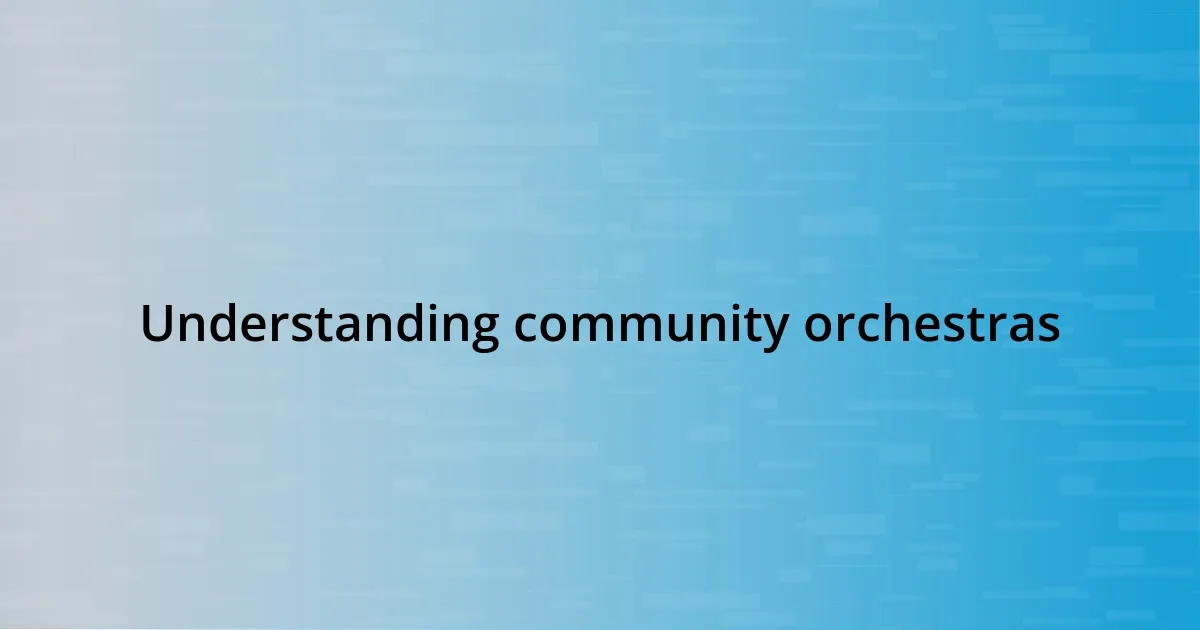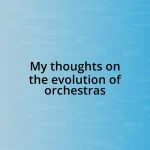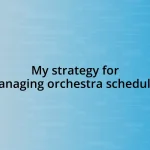Key takeaways:
- Community orchestras foster connections and friendships among diverse musicians, enriching personal growth and social bonds.
- Engagement initiatives like workshops and collaborations with local businesses strengthen ties with the community and enhance audience participation.
- Challenges such as funding constraints and skill diversity require thoughtful management to maintain harmony and inclusiveness.
- Strategic use of social media can help attract new audiences and create a sense of accessibility and community involvement in performances.

Understanding community orchestras
Community orchestras play a vital role in fostering musical culture within local communities. I remember my first experience attending a concert—there was an undeniable warmth in the air, and I could see musicians of all ages sharing their passion for music. It made me wonder: how can such a diverse group come together to create something so beautiful?
These orchestras often serve not just as a platform for performances but also as a social hub where relationships are forged. I once met a violinist who shared how she met her best friend at rehearsals—someone she might never have crossed paths with otherwise. Isn’t it fascinating how music can connect people in such unexpected ways?
Moreover, community orchestras offer invaluable opportunities for personal growth and development, both for musicians and audience members. Many of the players I’ve met have expressed how much they’ve learned from collaborating with others, which prompts me to ask: what might we gain by stepping outside our own musical comfort zones? The beauty of these ensembles lies in their ability to inspire not just creativity, but a shared journey of discovery.

The impact on musicianship development
The experience of playing in a community orchestra profoundly shapes musicianship development. I recall the first time I mastered a challenging piece during rehearsal. It wasn’t just about hitting the right notes but about feeling the music’s heartbeat alongside fellow musicians. The energy exchanged in those moments boosted not only my confidence but also my overall understanding of ensemble playing, revealing how intricate and beautiful cooperation can be.
Learning from seasoned musicians in community orchestras is another aspect that enhances our musical journey. I remember a particularly enlightening session where a mentor took the time to break down the nuances of phrasing. The way he explained articulation made me see every note as a story waiting to be told. This mentorship creates an environment rich in learning, where musicians can explore different techniques and interpretations, paving the way for growth.
Engaging with a diverse group of musicians opens one’s ears and mind to new perspectives, significantly enriching a musician’s skill set. I had the chance to collaborate with a percussionist who introduced me to rhythm styles I had never encountered. Through this experience, I learned to listen differently, becoming more adaptable in my playing. These interactions undoubtedly cultivate adaptability and creativity, essential traits for anyone looking to advance their musicianship.
| Aspect | Impact on Musicianship |
|---|---|
| Collaboration | Fosters team dynamics and enhances listening skills. |
| Mentorship | Provides guidance and teaches new techniques, enriching musical knowledge. |
| Diversity | Exposes musicians to varied styles, promoting adaptability and creativity. |

Community engagement through orchestras
The bond that forms through community orchestras is truly special. I remember volunteering at a local concert, distributing programs and soaking in the excitement of the audience. The shared buzz—everyone from grandparents to young children eagerly waiting for the performance—created a sense of belonging that’s rare to find. It wasn’t just about the music; it was about the connections made and the memories created around that shared experience.
- Orchestras host workshops and events that invite community participation, encouraging more people to engage with music.
- These events often lead to partnerships with local schools, allowing students to experience live music firsthand.
- Personal stories and interactions become woven into the fabric of each concert, fostering a collective memory within the community.
Every time I attend a performance, I’m reminded of the joy that comes from watching familiar faces in the audience. There’s a palpable energy that fills the room when friends and neighbors come together, united by a love for music. One concert in particular stands out; I witnessed a mother and daughter embrace after a heartfelt piece. Their shared tears of joy were a beautiful representation of how music transcends language and builds deeper emotional connections. In such moments, it’s clear that community orchestras are more than just musical ensembles—they are heartstrings tying communities together in harmony.

Building lasting relationships in orchestras
Building lasting relationships in orchestras goes beyond music; it’s about the camaraderie formed through shared efforts. I recall a particularly challenging rehearsal where we struggled with a complex symphony, and amidst the stress, laughter broke out. That lighthearted moment reminded me that we were all in it together, fostering bonds that went beyond our instruments. Isn’t it fascinating how music can create friendships in the most unexpected ways?
Every performance is an opportunity to deepen these connections. I vividly remember post-concert gatherings where we would discuss the evening’s highlights, often sharing personal stories related to the pieces we performed. These interactions not only enhanced our understanding of the music but also laid the groundwork for supportive relationships. Isn’t it amazing how discussing a piece can reveal the depths of one’s personality and experiences?
Over the years, I’ve seen friendships blossom that last well beyond the concert stage. One of my closest friends now met while playing in the same section; our late-night practice sessions evolved into a cherished friendship filled with inside jokes and shared aspirations. Reflecting on these moments, I often wonder: how many friendships could be sparked by simply picking up an instrument and playing together? The beauty of community orchestras lies in these enduring ties, transforming music into a pathway for lifelong connections.

Challenges faced by community orchestras
Navigating the world of community orchestras comes with its fair share of challenges. Funding, for instance, is a constant concern. I remember a particularly difficult season when our orchestra had to cut back on rehearsals due to financial constraints. That feeling of uncertainty created tension among members, as everyone wondered how we could continue our passion without the necessary resources. Have you ever been part of something you love but felt it slipping away due to reasons beyond your control?
Another challenge is the diversity of skill levels within the ensemble. I’ve played alongside musicians who are exceptionally skilled, and there have been times when I felt out of my depth. It’s a unique dynamic—balancing encouragement for learners while pushing seasoned players to excel. This blend can lead to frustration if not managed well. I once saw a new member struggle during a rehearsal, and our conductor skillfully paused the session to focus on fundamentals. This made me realize how crucial it is to create an environment where everyone feels valued and capable, regardless of their experience. How do we nurture talent without dimming the light of more experienced players?
Additionally, attracting audiences can be a hurdle that community orchestras consistently face. I recall the day we launched a marketing campaign using social media, hoping to reach new listeners. It was exciting, yet nerve-wracking to think if our efforts would pay off. Sometimes, I wonder what draws people in; is it the music itself, the performances, or perhaps the community spirit we foster? Ultimately, it’s essential for these orchestras not just to perform but also to resonate with the community they represent. It’s about finding ways to invite them in and make them feel a part of our musical journey.

Strategies for supporting local orchestras
Supporting local orchestras requires thoughtful strategies that resonate deeply with the community. One effective approach is to create outreach programs that invite local schools and youth organizations into the fold. I distinctly remember when our orchestra hosted a workshop for a nearby high school; witnessing the excitement on the students’ faces as they engaged with our musicians was priceless. It made me realize how pivotal these interactions are in nurturing a love for music among younger generations. Have you ever experienced the joy of sparking a new passion in someone? It’s truly a rewarding endeavor.
Another valuable strategy is to foster collaboration with local businesses. I recall one memorable season when our orchestra partnered with a local café for a series of “Concerts on the Patio.” This not only attracted a diverse audience but also helped the café thrive. It reinforced my belief that when local businesses invest in community arts, everyone wins. I often wonder, how can we expand such partnerships to create a thriving cultural ecosystem in our towns?
Finally, utilizing social media as a tool for engagement can significantly bolster support for local orchestras. I saw firsthand how our use of live behind-the-scenes streaming during rehearsals created buzz and excitement. It made our performances feel more accessible, allowing those who might have been hesitant to step into a concert hall to connect with us in a new way. Isn’t it fascinating how technology can bridge gaps and invite people into our world? By sharing our journey online, we invite the community to not just witness but be part of our musical narrative.















